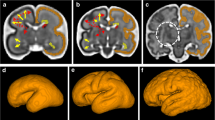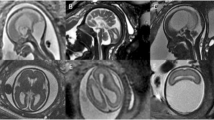Abstract
Introduction
Ganglionic eminence (GE) is a transient fetal brain structure that harvests a significant amount of precursors of cortical GABA-ergic interneurons. Prenatal magnetic resonance (MR) imaging features of GE anomalies (i.e., cavitations) have already been reported associated with severe micro-lissencephaly. The purpose of this report was to illustrate the MR imaging features of GE anomalies in conditions other than severe micro-lissencephalies.
Methods
Among all the fetuses submitted to prenatal MR imaging at our center from 2005 to 2014, we collected eight cases with GE anomalies and only limited associated brain anomalies. The median gestational age at the time of MR imaging was 21 weeks ranging from 19 to 29 weeks. Two senior pediatric neuroradiologists categorized the anomalies of the GE region in two groups: group one showing cavitation in the GE region and group two showing enlarged GE region. For each fetal case, associated cranial anomalies were also reported.
Results
Five out of the eight cases were included in group one and three in group two. Besides the GE region abnormality, all eight cases had additional intracranial anomalies, such as mild partial callosal agenesis, vermian hypoplasia and rotation, cerebellar hypoplasia, ventriculomegaly, enlarged subarachnoid spaces, molar tooth malformation. Ultrasound generally detected most of the associated intracranial anomalies, prompting the MR investigation; on the contrary in none of the cases, GE anomalies had been detected by ultrasound.
Conclusions
Our observation expands the spectrum of human GE anomalies, demonstrating that these may take place also without associated severe micro-lissencephalies.





Similar content being viewed by others
References
Letinic K, Zoncu R, Rakic P (2002) Origin of GABAergic neurons in the human neocortex. Nature 417(6889):645–649
Ma T, Wang C, Wang L, Zhou X, Tian M, Zhang Q et al (2013) Subcortical origins of human and monkey neocortical interneurons. Nat Neurosci 16:1588–1597
Del Bigio MR (2011) Cell proliferation in human ganglionic eminence and suppression after prematurity-associated haemorrhage. Brain 134:1344–1361
Arshad A, Vose LR, Vinukonda G, Hu F, Yoshikawa K, Csiszar A, et al. (2015) Extended Production of Cortical Interneurons into the Third Trimester of Human Gestation. Cereb Cortex
Colombo E, Collombat P, Colasante G, Bianchi M, Long J, Mansouri A et al (2007) Inactivation of Arx, the murine ortholog of the X-linked lissencephaly with ambiguous genitalia gene, leads to severe disorganization of the ventral telencephalon with impaired neuronal migration and differentiation. J Neurosci 27:4786–4798
Friocourt G, Parnavelas JG (2010) Mutations in ARX result in several defects involving GABAergic neurons. Front Cell Neurosci 4:4
Righini A, Frassoni C, Inverardi F, Parazzini C, Mei D, Doneda C et al (2013) Bilateral cavitations of ganglionic eminence: a fetal MR imaging sign of halted brain development. AJNR Am J Neuroradiol 34:1841–1845
Guibaud L, Selleret L, Larroche JC, Buenerd A, Alias F, Gaucherand P et al (2008) Abnormal Sylvian fissure on prenatal cerebral imaging: significance and correlation with neuropathological and postnatal data. Ultrasound Obstet Gynecol 32:50–60
Fallet-Bianco C, Loeuillet L, Poirier K, Loget P, Chapon F, Pasquier L et al (2008) Neuropathological phenotype of a distinct form of lissencephaly associated with mutations in TUBA1A. Brain 131:2304–2320
Fallet-Bianco C, Laquerrière A, Poirier K, Razavi F, Guimiot F, Dias P et al (2014) Mutations in tubulin genes are frequent causes of various foetal malformations of cortical development including microlissencephaly. Acta Neuropathol Commun 2:69
Steinecke A, Gampe C, Nitzsche F, Bolz J (2014) DISC1 knockdown impairs the tangential migration of cortical interneurons by affecting the actin cytoskeleton. Front Cell Neurosci 8:190
Lewis DA (2000) GABAergic local circuit neurons and prefrontal cortical dysfunction in schizophrenia. Brain Res Rev 31:270–276
Parazzini C, Righini A, Rustico M, Consonni D, Triulzi F (2008) Prenatal magnetic resonance imaging: brain normal linear biometric values below 24 gestational weeks. Neuroradiol 50:877–883
Author information
Authors and Affiliations
Corresponding author
Ethics declarations
We declare that all human studies have been approved by the Internal Review Board and have therefore been performed in accordance with the ethical standards laid down in the 1964 Declaration of Helsinki and its later amendments. We declare that all patients gave informed consent prior to inclusion in this study.
Conflict of interest
We declare that we have no conflict of interest.
Rights and permissions
About this article
Cite this article
Righini, A., Cesaretti, C., Conte, G. et al. Expanding the spectrum of human ganglionic eminence region anomalies on fetal magnetic resonance imaging. Neuroradiology 58, 293–300 (2016). https://doi.org/10.1007/s00234-015-1622-5
Received:
Accepted:
Published:
Issue Date:
DOI: https://doi.org/10.1007/s00234-015-1622-5




